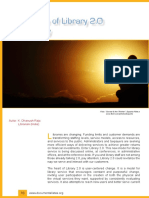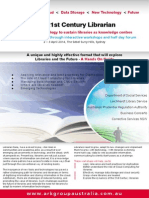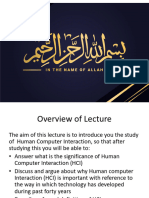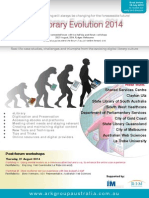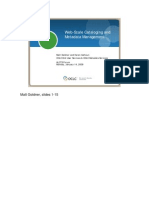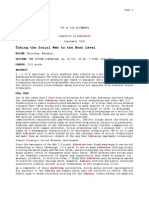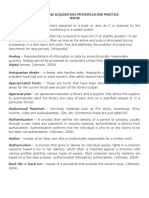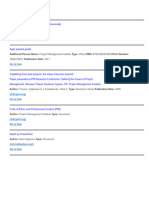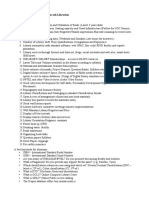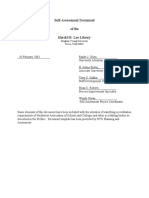Are You Feeling The Pressure?
The Ratcheting Up of Library Technology
Rochester Regional Library Council November 20, 2008 Steven Bell, Associate University Librarian Temple University bells@temple.edu
�Four Parts To This Workshop
Technology trends, change and the rachet
Strategies for technology adoption in library organizations Creating better library user experiences Keeping up with technology
�Part I
Technology trends Technology change The technology ratchet
�Forces of Change
Demographics
Technology Librarians
Socio-Econ
Policy
Institution
���Only The Paranoid Survive
Andy Grove, Founder of Intel, wrote this book about surviving competition and change Wrote about the inflection curve We have no control over the forces of change but we can control our strategy
��Source: BusinessWeek IN Supplement June 11, 2007 http://www.businessweek.com/magazine/content/07_24/b4038404.htm
�Source: BusinessWeek IN Supplement June 11, 2007 http://www.businessweek.com/magazine/content/07_24/b4038405.htm
�Source: Sharing, Privacy and Trust in Our Networked World, OCLC, 2007
�Source: Sharing, Privacy and Trust in Our Networked World, OCLC, 2007
�From: Curran, Murray and Christian. Taking the information to the public through Library 2.0. Library Hi-Tech Vol. 25. No. 2, 2007 pp288-297.
�The Ratchet Metaphor
1. What is a ratchet? 2. Think of it as a spiral pressure increases on the center
�Technology Ratchet
What Technologies Make You Feel Pressured?
Web Technologies
blogs, wikis, rss, aggregators, social collaboration tools, social networks, flickr, tagging, folksonomies, gaming, podcasts
Library Technologies
link resolvers, federated search, institutional repositories, open worldcat
Academic Technologies
courseware, hardware/software, learning objects screencasting
��Part II
Strategies for technology adoption Bandwagon jumping and shiny toys Tips for technology adoption
A thoughtful approach - design change
����Technology Implementation Wiki Case Study
1. Identify problem possible solutions 2. Wiki identified as technology with potential 3. Learn more about wikis 4. Practice editing a wiki 5. Obtain a wiki account for experimentation 6. Show staff but allow time for acceptance 7. Identify compassionate pioneer 8. Allow pioneer to experiment and discover 9. Develop strategy for implementation 10. Incorporate staff training/learning 11. Implement 12. Evaluation
�Reverse The Technology Ratchet
Consider the opportunity costs Balance experimentation (play) and investment of time
Pick your edge lead or trail
Identify your compassionate pioneers Reverse mentoring Make a plan and let it guide but there are exceptions
�Part III
Creating better library user experiences UX Trends The experience economy
The design approach
�The Age of User Experience
What Defines It? Make it simple Complexity/Confusion are deal breakers If you have to learn it we have a problem Good design is critical Features get used if they provide a good user experience
Source: EWeek.com
- http://www.eweek.com/article2/0,1895,1914495,00.asp
�Whats Broken - Activity
This is a 2-4 minute activity Think about something at your library that you think is broken. Either something that doesnt work or a solution that has no problem attached to it. Just jot down a description of that on a sheet of paper Also why do you think it is broken?
�Google Experience vs. Library Experience
GOOGLE
Simple Satisfies instant gratification No unnecessary features Millennial seal of approval
LIBRARY
Complex Takes time to learn Many features Added value Better quality Personalized help
Simplicity Complexity Conundrum how to resolve the tension between the two yet encourage quality research and education
�What Do Libraries Offer? Fear of Complexity
�Whats Broken At Your Library?
Library anecdote This is broken See Seth Godins blog or his presentation at GEL2006
�Designing A Better Experience The Experience Economy
Book about designing user experiences
Moving from commodities to experiences Make it memorable It has to work
�Word Association
What comes to your mind when you hear the word
DESIGN
Write it down
�Question
Do you think library workers are designers? Yes or No
�What is Design Anyway?
�What They Have in Common
The Design Approach! empathic thinking identifying the problem before the solution brainstorming process prototyping process formative/summative evaluation
�Key Points: Identify the problem before the solution
Understand the users Work creatively to identify and develop the solution Bottom Line its how designers approach challenges
�Design Thinking
Approaching library problems the way designers approach design problems. Librarianship by Design draws mostly from instructional design for influence How is it different? Thoughtful process to create new services Integrates needs assessment and evaluation User-centered not technology-driven
�Thinking Like A Designer
�DT vs ISD
In what ways are design thinking and instructional systems design similar Compare ADDIE and the IDEO Method ADDIE Analysis Design/Develop Implement Evaluate IDEO Understand/Observe Visualize/Brainstorm Implement Evaluate/Refine
�Design Thinking
Empathic Design
Prototyping process
Formative and summative evalution
��UX: What is it?
A Definition:
UX is the quality of experience a person has while interacting with a specific design.
�Customer Service vs. User Experience
CS
UX
Caring Nice Go extra mile Courteous Training Satisfied Patron Fast/Convenient Answers Rule Bending
Holistic Totality of Experience WoW Factor (not broken) Memorable Loyalty Localized Design-based What kind of experience Understanding user
�UX: The Totality of the Experience
Not just one fragmented experience More than one WOW Must be designed into the larger library service operation Creates equal expectations throughout library
�From Customer Service to Experience
Start with core values design from there Focus on relationship design build trust and create meaning for users Its more than customer service Must be useful and usable (simple/complex)
Think about UX as the brand
�Design a Better Library User Experience
Design
for local audiences
Design for personal experiences Design for outcomes not features
Design for success stories
Design for user education
�Add Your Voice To The Conversation
�Part IV
Strategies for keeping up and keeping found things found Professional development Going beyond librarianship Coping with technology change
�What Are Keep Up Needs
Three Types
1. Databases/Systems have to learn new features, interface changes, upgrades; formal training may be needed. example RefWorks, VR systems, etc.
2. New web technologies social collaboration tools; learn by playing/experimenting example scholar; jing; facebook apps 3. New developments in peripheral fields computing; instructional technology
�Challenge And Opportunity
Challenge: Time constraints and cost
Opportunity: Use technology to learn about technology
�Leverage Tech For Training
Resources:
WebJunction discussion lists / online training Sirsi Dynix - webinars OPAL online training ACRL E-learning Blended Librarian webcasts College of DuPage Soaring to Excellence DVDs
�TBLC Play Days?
Sponsor an online technology summit
Base it on PLCMCs 23 Days program Staff development works bests when library staff are learning together Opportunity for reverse mentoring
�Keeping Up With Technology
Keeping up promotes technology awareness and innovation Keeping up keeps you change ready Journals, newsletters, TOC alerts, RSS and aggregators, webcasts, and more Develop a personal strategy for personal professional development visit the Keeping Up Web Site for more ideas
�How Are We Keeping Up?
1. Read Journals 174 2. Attend Local/Regional Conferences 149 3. Attend National Conferences 147 4. Exchange Information With Colleagues 147 5. Follow a Discussion List 136 Then: Regularly Visit a Discipline Specific Website 77 Read a Discipline Specific Blog 27 N=174
�Time Spent On Keeping Up
Less Than 1 Hour Per Week 21% 1-3 Hours Per Week 58% 4-6 Hours Per Week 15% 7-10 Hours Per Week 4% 10+ Hours Per Week 2% N=174
�Why Keep Up?
Maintain professional skill level
Stay abreast of new technology and applications
Follow emerging trends in profession
Exchange information with colleagues
Career growth (seek new opportunities)
Rapid technological change demands that we invest time in keeping up!
�Key Keeping Up Technologies
E-Newsletters
Web Pages (change detection) TOC Alerts News Aggregators Personalized Alert Services Organizing What You Find
�Get Better At Spotting the Trends
Pay attention to societal/cultural change
Question how demographic trends will impact
libraries
Follow recent technology developments and
reports for coming innovation
See Trendwatching.com and others
If you havent yet, start with OCLCs environmental
scan and other reports of this type.
�Change: Learn To Evolve
Example One Jim Carrolls squirrel experiment
Example Two David Bishop, retired University Librarian at Northwestern U.
�Wed Like To See Better Research
�And Help Students Take The Right Path
�Final Thoughts
Be open to new technology but resist pressure to do it all Allow opportunities for staff development and time for play Before you go too far connect new technology to your library plan As always, keep up, talk to colleagues, visit other libraries, share with co-workers
�Questions Discussion
�����������The Intersection of BL & DT
What do Blended Librarianship and Design Thinking have in common?
Similar approach to identifying problems and developing solutions Boundary Crossers:
A boundary crosser is someone who blends multiple skills into one profession. Pink says while detailed knowledge of a single area (e.g., traditional librarianship) once guaranteed success, today the top rewards go to those who can operate with equal aplomb in starkly different realms.
Work collaboratively with others in peripheral professional areas
�����������������������Organizing What You Find
���Sarah Longs The Daily Herald August 13, 2006
�David Bishop Retired University Director Northwestern University
�Mashable.com waves of technology












